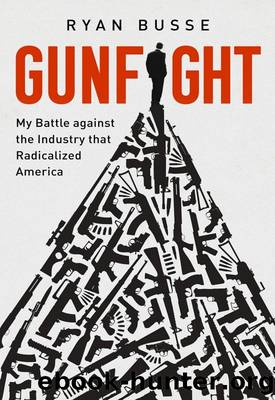Gunfight My Battle Against the Industry that Radicalized America by Ryan Busse

Author:Ryan Busse [Busse, Ryan]
Language: eng
Format: epub
Published: 0101-01-01T00:00:00+00:00
FIFTEEN
TUPPERWARE PARTY
DESPITE SARAâS COMFORTING REMINDER THAT I COULD âstop pretending,â my problem was that I chose to stay inside an industry that required someone like me to be good at pretending. The angry reaction to my advocacy made me realize that I was witnessing a growing move toward radicalization. Much of it was subtle, but there were important public events that highlighted the slide too, and I should have seen it coming well before my epiphany in 2004. I had even been witness to many of those events, including at the NRA convention two years earlier.
âYou are why Al Gore isnât in the White House!â Wayne LaPierre yelled to the packed ballroom of nearly five thousand people at the 2002 NRA convention in Reno. I was there along with Leslie, Allen, Dwight, Bobby, Gibbs, and the rest of Kimberâs growing team. Even Darrell made it. Every other industry leader was there too, and many of us listened closely as the crowd applauded at the power that the NRA had wielded in the 2000 presidential election.
The NRA had, in fact, played a central role in that contentious election. In the weeks leading up to Election Day, and in a harbinger of the 2016 and 2020 elections, Charlton Heston embarked on a sixteen-city tour through Americaâs presidential battleground states. Hestonâs NRA events were passionate and raucous precursors to Donald Trumpâs furious MAGA rallies. Attendees held up signs like âGore Communist Scum,â and Moses spoke openly about finding a rope so that he could form a lynch mob for Democrats. The cultural fervor combined with Hestonâs celebrity to form powerful and emotional events. The crowds swelled and swooned, and soon more people attended NRA rallies than Goreâs own campaign events. In one of them, Moses highlighted the power of the NRA and offered a prediction: âSome papers have said if Gore loses those swing states it will be because of the NRAâs effort.â1
As I watched in Reno, I thought about how far the organization had come in just three years. After Columbine, this big annual convention had been canceled; the only events were a few business meetings and the resulting protests. Back then, the mood was much different. The industry faced potential waves of new gun regulations, a traitorous Smith & Wesson CEO, and reactions to what was then Americaâs deadliest school shooting. But by 2002, many of those concerns had dissipated, and the atmosphere in Reno was celebratory. Because of Wâs big electoral win, there was even talk about passing a law to make the municipal lawsuits go away too.
LaPierre felt the energy surge, and so could Jim Baker, the organizationâs longtime lobbyist and resident Washington insider. Baker, a dead ringer for John Slatteryâs character Roger Sterling in the AMC series Mad Men, wore tailored suits and dined in the finest restaurants. He was a smooth old-school lobbyist with a huge Rolodex who worked in the halls of Congress as the director of the NRA Institute of Legislative Action (NRA-ILA). Baker made no bones about being a partisan, but he also had a reputation as a dealmaker.
Download
This site does not store any files on its server. We only index and link to content provided by other sites. Please contact the content providers to delete copyright contents if any and email us, we'll remove relevant links or contents immediately.
Machine Learning at Scale with H2O by Gregory Keys | David Whiting(4069)
Harry Potter and the Goblet Of Fire by J.K. Rowling(3755)
Never by Ken Follett(3750)
Unfinished: A Memoir by Priyanka Chopra Jonas(3304)
Fairy Tale by Stephen King(3185)
The Man Who Died Twice by Richard Osman(2977)
Will by Will Smith(2762)
Rationality by Steven Pinker(2265)
The Dark Hours by Michael Connelly(2208)
It Starts With Us (It Ends with Us #2) by Colleen Hoover(2170)
The Storyteller by Dave Grohl(2146)
Can't Hurt Me: Master Your Mind and Defy the Odds - Clean Edition by David Goggins(2127)
The Dawn of Everything: A New History of Humanity by David Graeber & David Wengrow(2102)
Friends, Lovers, and the Big Terrible Thing by Matthew Perry(2095)
The Becoming by Nora Roberts(2054)
The Stranger in the Lifeboat by Mitch Albom(2025)
Cloud Cuckoo Land by Anthony Doerr(2010)
Einstein: His Life and Universe by Walter Isaacson(1940)
Love on the Brain by Ali Hazelwood(1929)
